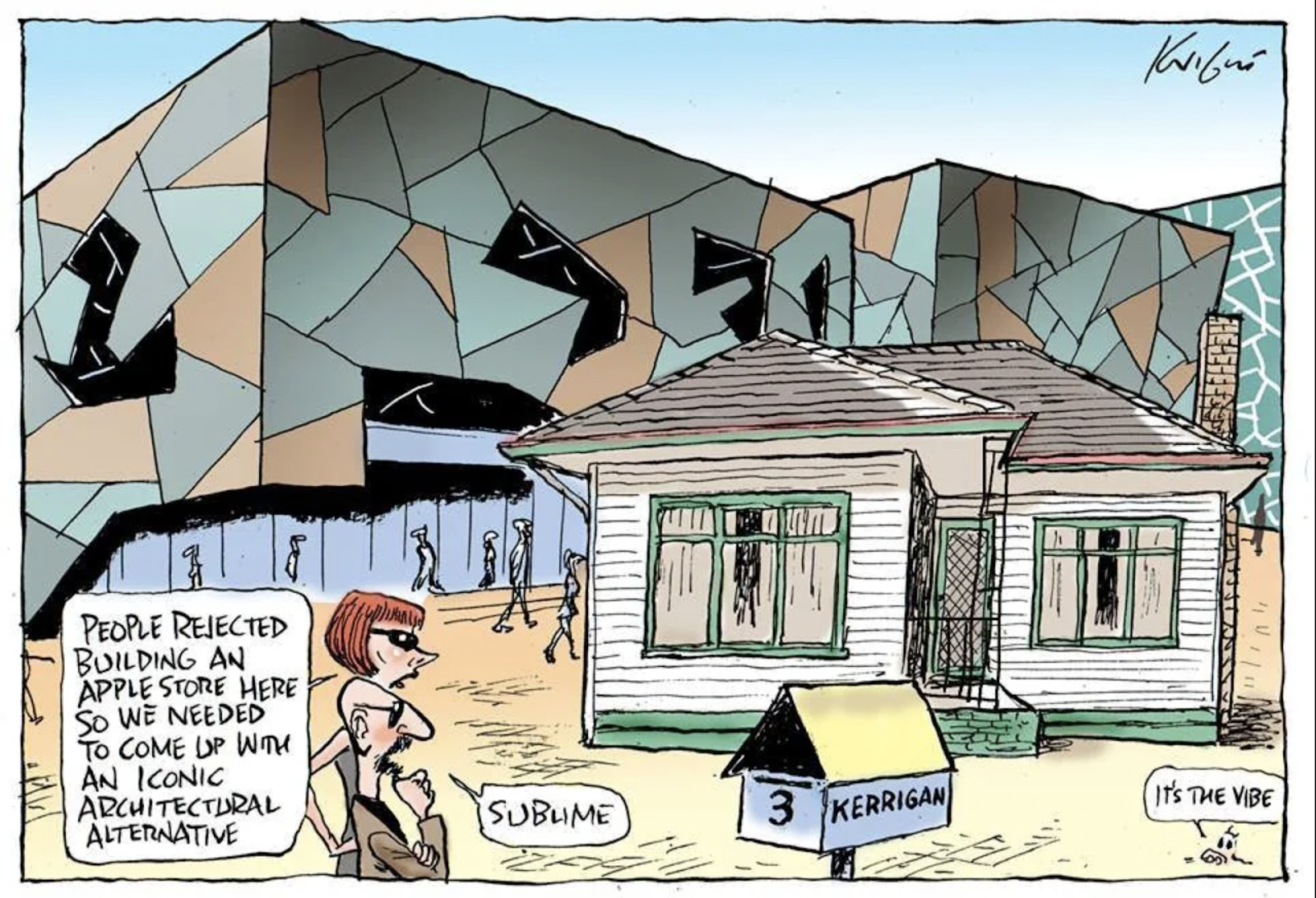
Annotating a Full-Mark Analysing Arguments Essay With a 50-Study-Scorer
Passively flicking through sample analysing arguments sample essays will not help you achieve those perfect scores in your SACs. Reverse-engineering a sample essay written by a 50-study-scorer may though! Analysing Arguments (formerly known as Language Analysis) is often perceived as easy and repetitive; this is partly true – but tasks of this nature are often the most difficult, in that it is extremely difficult to stand out from the crowd and impress the teachers and assessors, who are probably tired of reading the same thing over and over again. Our team has mastered the art of standing out – and, based on our combined experience of 30+ years, will analyse why this essay is Premier’s Award-level distinctive.
Introduction
Prompted by the controversial proposal for an Apple store to be built in Federation square, Susie O’Brien has composed an opinion piece entitled “Welcome to Apple Square, Victoria’s Latest Sellout” (Herald Sun, 20/12/17) for an audience of metropolitan Melburnians divided over the potential loss of an iconic cultural space. In an impassioned and fervent tone, O’Brien voices her outrage over the proposal, beckoning her readers to oppose the construction of the store due to its infringement on what is widely considered a hub of Melbourne life. Contrasting these views is Federation Square designer Donald Bates, who, in his opinion piece “Federation Square is exactly the right place for Melbourne’s new Apple store” (The Age, 21/12/17) authoritatively and prudently expresses his support of the new Apple store to his concerned Melbourne-based readers, citing the decision as consistent with the original intent behind the creation of Federation Square. Meanwhile, the cartoons by Jim Pavlidis (date unknown) and Mark Knight (22/12/17) aim to satirise the debate, with Pavlidis asserting that Melbourne citizens are taking the issue too seriously and Knight mocking the public for their refusal to embrace change.
Commentary: The introduction of the essay is comprehensive, clearly outlining the issue, title of the articles, specified the audience and the author’s tone. The information about the first opinion piece is well-connected to the analysis of the second piece, as well as the visuals by Pavlidis and Knight.
Body paragraph 1:
With the central aim of exposing the injustice inherent in a wealthy private corporation encroaching on iconic public space, O’Brien opens her piece with an impassioned appeal to economic fairness to highlight the impropriety of the proposed Apple store. Painting a highly negative portrayal of Apple Inc. through descriptors such as “tax-dodging multinational” and “erosion of public space to private corporations”, O’Brien seeks to capitalize on her local readership’s loyalty and patriotism towards the City of Melbourne to implicitly suggest that the building will endanger all that they hold dear, with the “well-used public building” replaced by “oppressive” international forces. Given the stark contrast between the comfort and sense of community in the “public amenity” and the sterility and coldness of the “private corporations”, readers strongly affiliated with the Square and all it represents are encouraged to view Apple Inc. as an almost evil corporation far removed from the cultural identity of Melbourne. The sense of injustice in such a corporation purchasing the “right to occupy” space in Federation Square is fortified by O’Brien’s enraged denigration of the company for paying a “tiny proportion” of only “$85 million” Australian tax compared to its “$8 billion local revenue”. In doing so, O’Brien firmly appeals to the working class reader’s sense of economic equity to condemn Apple for their opportunism in securing such a “prime slice of Melbourne real estate”. Taxpayers particularly concerned about the Melbourne economy are compelled to respond in outrage to the inequality of the situation in that their hard-earned money will be used to fund an enormously wealthy corporation’s project. Labeling the decision as “Victoria’s latest sellout” then confirms in the infuriated reader’s mind that the project is yet another one of the State Government’s fruitless attempts of developing the CBD that will result only in the defacement of a Melbourne icon.
Commentary: Opening strong with a detailed argument (with the tone integrated), the author shows her understanding of the task — you are expected to analyse the construction and delivery of the arguments. All quotes are integrated seamlessly into the anaysis; there is no listing or labeling of techniques here. Instead, the analysis of language, quotes and appeals is included to support an exploration of how the argument is formed. There are multiple ‘points of analysis’ or ‘blocks of analysis’, which leverage the shared impacts of different devices – combine them, and analyse them in one go.
Points of analysis:
- Appeal to economic fairness – Negative portrayal through the use of epithets such as “tax-dodging multinational” and “erosion of public space to private corporations”
- Contrast between "public amenity" and "private corporations" – Strong emotional language to make readers view Apple Inc. as an almost evil corporation far removed from the cultural identity of Melbourne
- Use of statistics to enhance the reader's sense of injustice – Appeal to the working class reader’s sense of economic equity to condemn Apple
- Labeling the decision as “Victoria’s latest sellout” confirms in the infuriated reader’s mind that the project is yet another one of the State Government’s fruitless attempts of developing the CBD that will result only in the defacement of a Melbourne icon.
Body paragraph 2:
O’Brien progresses into her piece in a more emphatic tone, aiming to embroil her readership with a sense of outrage over the loss of the iconic cultural and communal hub that is Federation Square. With the intent of galvanizing an emotional response from her Melburnian readers, O’Brien appeals to tradition in her assertion that the “exiting Yarra building” should be “retained” given it is part of the “original design for the square” and is used for “markets, public events and conventions”. In doing so, readers actively involved in the social or cultural life of Melbourne, or perhaps even those who passingly visit the Square as part of their daily commute, are positioned to view the proposed build as an unsolicited encroachment on the traditions of the lives of ordinary Melburnians, given the cultural significance Federation Square has as a symbol of Melbourne and even Australia. Juxtaposing the “thousands” who “flock” to the Square to “watch sporting events, hold protests, watch fireworks, film screenings and attend festivals and markets” with the “oppressive presence hulking over” the area serves then to further generate anger and resentment towards Apple for destroying the cultural activities of Melburnians. Given the connotations of community spirit and participation associated with the extensive list of activities that the space facilitates, diametrically opposed to the images of a gargantuan, imposing construction, readers are poised to completely reject such an inequitable proposal that, to them, should remain the “heart of the city.” The inclusion of a photograph depicting the “proposed flagship design” of the Apple store serves to bolster O’Brien’s portrayal of the building as an unnecessary obstruction in the cultural hub of Melbourne. With the instantly recognizable irregular geometric patterns of Federation Square surrounding the new “flagship” building, readers are reminded of the disruption that this building will create to their daily lives, having been accustomed to an open, public area rather than the more constricted and uninviting image the design suggests. Hence, readers, motivated by their strong sense of attachment to the traditions of Melbourne that Federation Square represents, are prompted into supporting O’Brien in her rejection of the new Apple Store.
Commentary: O’Brien’s tonal shift is mentioned here – the response shows an astute understanding of how language influences the readers. It is important to note that, linguistic decisions of the author can both elicit feelings and alter the position of the audience. The analysis mentions both the ways in which O’Brien prompts audiences into supporting her view, and sparks outrage within the readers. Connotations are also analysed here – specific word choices help put forward arguments and persuade target audiences.
Points of analysis:
- Emphatic tone to embroil readers with a sense of outrage
- Appeal to tradition – Juxtaposition of cultural activities with the imposing presence of the Apple store
- Connotations of community spirit and participation associated with the extensive list of activities that the space facilitates
- Inclusion of a photograph depicting the “proposed flagship design” of the Apple store
- Use of rhetorical questions to challenge readers
Body paragraph 3:
While O’Brien seeks to rally increased opposition towards the proposed build, Bates takes a reasoned approach in likening the initial resistance to the Apple Store to the public reception of the design of Federation Square itself. Establishing his credentials as the “director and co-founder of LAB Architecture Studio” who designed the Square by recalling “our” winning design, Bates immediately signals his authority over the issue as someone whose opinion overrides all others, given his knowledge and expertise as one of the “architects of the landmark”. Through this, readers concerned that the new building will encroach on the “original intent” of the cultural hub of Federation Square are assured that, given the endorsement of the proposal from the designer himself, the building is perhaps a beneficial addition to the Melbourne icon. Listing examples of sentiments against the new Federation Square design he had received “for five years (1997-2002)”, such as “This design has all the grace and charm of Godzilla” and “that it was unfortunate the Taliban couldn’t come to Melbourne to blow it up”, Bates amusingly divulges on the initial resistance the design had garnered from the public. In doing so, readers are subconsciously allowed to liken the construction of the Apple store to the designing of Federation Square; Bates aims to insinuate that an initially poorly-received Apple Store has the potential to become as well-loved and perhaps even as iconic as Federation Square, given the shift in public sentiment towards the Square from initial outrage to universal affection.
Commentary: Past VCAA examiners reports have clarified that there is no requirement for students to compare between texts in the exam – but do note that you are required to compare in your SAC. This essay is written in preparation for the exams; the topic sentence – with a small comparative component – has the effects of adding to the analysis’ coherence and flow. The analysis of the author’s credibility, a logos analysis, is a great base for further discussion.
Points of analysis:
- Reasoned approach – Establishing authority over the issue
- Listing examples of sentiments against the new Federation Square
- Comparison of the initial resistance to the Apple Store with the public reception of the design of Federation Square
Having divulged the parallels in initial reception of Federation Square and the Apple Store, Bates transitions into a rational justification of the building as an affirmation of the original intent of what the public square represents. Appealing to the city-going local’s feeling of pride towards “the vibrancy that is Melbourne’s unique CBD” in phrases such as “Federation Square is Melbourne” and “a precinct that conjoins the civic, the cultural and the commercial”, Bates seeks to inspire a sense of collective appreciation and enthusiasm for “one of the world’s best public squares”, allowing his readership to become more receptive to his subsequent argument. The alliterative emphasis in the triad “the civic, the cultural and the commercial” serves to bolster the image of Federation Square as a central hub for the Melbourne community which links all aspects of daily life; readers are implicitly urged to associate such positive connotations with the new Apple Store given Bates’ assertion that it is an “affirmation” of the “aspiration of Fed Square” to be the “centre of action in Melbourne”. It is Bates’ aim to assuage the concerns of readers who believe that the “Apple Global Flagship” will threaten to destroy the “vibrancy” of the original Square, instead insisting that it is not only in line with the “original intent” of the space, but will improve the “operational impost”, creating a “more logical connection of the activities of Fed Square”. Metropolitan readers, reassured by the enthusiasm of the architect behind their much-loved city hub, are thus more inclined to view the development of the site in a positive light, given that it will benefit the communal activities that Federation Square is prized for.
Commentary: This paragraph is the perfect illustration for our ‘hierarchical analysis’ strategy, exclusively taught to Lindsey’s VCE students – we will write a blog on this shortly. It starts with a broader ethos-based analysis (appeals), and zooms in, discusses word-level features, i.e. the alliteration of “the civic, the cultural and the commercial”. The connotations of the words quoted are also parts of, what we call, the micro-level analysis. This strategy allows us to construct paragraphs that flow incredibly well, and avoid the trap of ‘listing techniques’ mentioned every year in the Examiner’s Report.
- Appealing to the city-going local’s feeling of pride
- The alliterative emphasis in the triad “the civic, the cultural and the commercial”
- Positive connotations with the new Apple Store given Bates’ assertion that it is an “affirmation” of the “aspiration of Fed Square” to be the “centre of action in Melbourne”
Visual analysis:
While O’Brien and Bates assume a clear stance for or against the proposed building, Pavlidis’ cartoon aims to satirise the public debate by suggesting that Melburnians are outraged over a minor development to their city. The cartoon features a water-coloured overview of Federation Square, with a cluster of multi-coloured dots gathered beside the central building, symbolic of Melbourne locals. The speech bubble that reads “We grovelingly acknowledge the future custodian of this land – Apple Inc.” is a deliberate play on the traditional Acknowledgement of Land recited out of respect for the Aboriginal “custodian[s]”; in comparing the decision to build an Apple Store on the “land” of Federation Square with the colonization of Australia, Pavladis cynically reduces the Apple Store issue to the trivial while at simultaneously reflecting the public sentiment that “Apple Inc.” is exploiting the public space for their own monetary gain. Viewers, outraged by this idea, are hence poised to re-evaluate their strong beliefs about the ludicrousness of an Apple Store in Federation Square, given the comparative insignificance of the issue in the grand scheme of things.
Knight’s cartoon similarly mocks public opposition of the Apple Store in arguing that expectations regarding the visual appeal of new buildings must be lowered. Featuring a pair of archetypical, modern designers looking at their “architectural alternative” of a traditional residential home situated in Federation Square, the cartoon insinuates that public demand of new buildings that fit the “iconic” character of Federation Square will always result in disappointment and objections. The irony of the conventionality of the house contrasted with the designers’ descriptors “iconic” and “sublime” is Knight’s attempt to amusingly relate to viewers that the development of a modern Apple Store is a more desirable alternative than regressing to something more traditional and uninspired. Readers perhaps overly critical towards the proposed design are invited to respond with bemusement over the absurdity of such an image and conclude that Melburnians will never be completely satisfied with any change to Federation Square, thus perhaps decreasing their objection towards the new Apple building.

Commentary: These visuals are analysed separately as they are not parts of the main text. Each contains a contention – to be treated as an argument, clearly outlined in your body paragraphs. Multiple visual elements are analysed in both paragraphs: the colour, speech bubbles, relationships between objects, irony.
Conclusion:
While O’Brien’s piece focuses on galvanizing the reader’s emotional response to the encroachment of the Apple Store on a hub of cultural and social activity, Bates exploits his architect-identity to reason that the Store is completely in line with the character of Federation Square, touting it as a logical progression in the development of the Melbourne CBD. The cartoons, however, adopt a more subtle approach, with Pavlidis mocking the seriousness of the debate and Knight conceding that the public will always remain divided when it comes to changes that depart from age-old tradition.
Commentary: While it is not compulsory to write a conclusion, it shows great control, confidence and skills, especially in terms of time management. The conclusion creates a sense of finality, and reiterates the points explored in the body paragraphs – a gentle reminder that you deserve those perfect scores!
Commentary by Lindsey Dang



